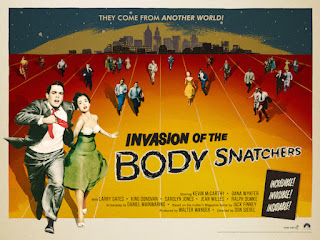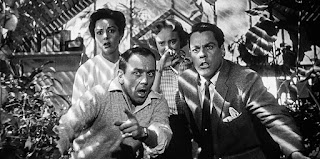Don Siegel Helms a Memorable Invasion
Ranking high
among both Hollywood’s most satisfying low-budget sleepers and the 1950’s crop
of sci-fi features involving ominous interference from galaxies far away,
director Don Siegel’s tense, fast-paced Invasion
of the Body Snatchers takes the idea of idyllic small-town America and
turns it into a dark, paranoiac nightmare. The first and possibly best film
adaptation of Jack Finney’s ingenious 1954 novel The Body Snatchers (first serialized in Collier’s magazine), Siegel’s
1956 Invasion utilizes ideal
on-location shooting around Los Angeles to vividly depict a vile other-worldly
threat infiltrating itself into the seemingly normal façade of fictional Santa
Mira, a placid, friendly community until residents start becoming, one-by-one, cool
and distant. Aided by a concise, first-class script by Daniel Mainwaring that
cleverly leaves much to the viewer’s imagination, while addressing the dangers
of harboring a mob mentality wherein any sign of individualism is destroyed and
stark, stylized cinematography by Ellsworth Fredericks that perfectly captures
the mounting insidiousness pervading the story’s locale as “pod people” take
over humanity, Invasion pointedly
illustrates the havoc resulting in a society wherein fear and mass hysteria
rule the day, during a time wherein irrational panic surrounding the “Red
Scare” was recklessly causing damage to America’s democratic structure and the
lives of many accused of harboring “un-American” sentiments.
Invasion
stands apart from other movies of its genre by maintaining an element of
mystery concerning the otherworldly violators and the threat they pose to
humanity, and Siegel does a masterful job in upholding this enigmatic aura,
while keeping the thriller flowing using simple, direct means, thereby enabling
the story to have maximum impact on audiences without any ideas of artistic
pretense cluttering up the proceedings. It’s never fully explained exactly why
or how people are being overtaken by the alien pods, which makes the narrative
possibly more chilling than if mankind was faced with aliens in a more overt
manner, ala War of the Worlds or It Came from Outer Space.
A terrific cast, who
whole-heartedly commit to the movie’s fantastic premise with conviction and
flair, greatly aid Siegel in maintaining an eerie atmosphere as the story
unfolds, along with beneficial traces of humor Siegel and Mainwaring throw in
to counter the ever-rising tension. Although the film was shot in under a
month, the playing upholds a consistently high level of quality due to a fine
line-up of stalwart pros, from Whit Bissell and Richard Deacon, who help sell
the framing device tacked on after principle photography concluded in order to
provide a more upbeat ending, to bit players effectively conveying the
sinister, glacial nature of the transformed, including soon-to-be-on-the-rise director
Sam Peckinpah as Charlie, the seemingly innocent basement meter reader later
seen among the posse out to chase down Dr. Miles Bennell and his former and
current lady love Becky Driscoll, the last couple in town yet to be overtaken
and zombified by the title characters.
As Miles and Becky, leads Kevin
McCarthy and Dana Wynter expertly serve as audience identification points, with
viewers quickly drawn into the plight of the attractive duo, as their rekindled
romance is abruptly put on hold to focus on a fight for survival. McCarthy
skillfully alternates between adopting the calm, rational sensibility befitting
the doctor as he attempts to make sense of the increasingly unusual conduct of
his community, with a more intense performance style as Miles’ world is turned
inside-out after he discovers the literally out-of-this-world force behind the behavioral
shift found in his friends and colleagues, adding an understandably frantic
demeanor to Miles as he desperately seeks a way out of town for himself and
Becky. As his intended, Wynter has exceptional chemistry with McCarthy; they
make an ideal team both romantically- there’s a few provocative exchanges
regarding bedside manners and such surprising for a 1956 feature- and in the
action-oriented sequences.
McCarthy had previously used his Actor’s
Studio acumen to break through on stage and screen as Biff in Death of a Salesman (with a resulting
Oscar nomination providing a great start to a fruitful and lengthy career in
films, television and theater) and he brings an earnestness, energy and skill
to his most famous role that adds invaluable creditability to Invasion. Substitute a more standard and
less dedicated leading man of the period as Miles, and the implausibility of
the film’s storyline could turn the whole affair into a laughful B worthy of a Mystery Science Theater salute. However,
McCarthy invests every ounce of his considerable talents into making Miles a
sympathetic, flesh-and-blood protagonist, resulting in one of the most
memorable and convincing heroes found in a 1950’s film. Similarly, Wynter lends
an intelligent, mature underplaying to her signature role as Becky that allows
her to stand above the typical ingénue found in films, sci-fi genre or
otherwise. She also adds a distinct air of class and (at least early on, before
things get hectic to the nth degree) serenity to the part that establishes a
nice synchronicity between Becky and Miles; both behaviorally and physically,
McCarthy and Wynter make a perfect pairing as Invasion’s resident couple-on-the-run, and the audience follows their
“Evasion of the Body Snatchers” attempts with rapt concern, due to the admirable
credibility the stars bring to their meaty assignments.
Other Santa Mira locals making an
impression are Virginia Christie as Becky‘s skittish cousin Wilma, who
assertively informs Miles she’s convinced her uncle Ira isn’t what he appears, thereby
kicking the plot into high gear. Christie nicely conveys Wilma’s unsettled
sense of dread concerning the unknown, and what lies ahead for her once Miles
and Becky depart, then later vividly depicts the sinister edge driving Wilma’s
duplicitous nature as she genially assures Miles everything is A-Okay. King
Donovan and Carolyn Jones make perhaps the strongest impression as Jack and
Teddy, the couple who alert Miles and Becky to the actual physical threat
involved in the odd events pervading the townsfolk. Donovan and Jones are given
a few humorous lines to add a little diversion to the suspense and, as usual
throughout the decade, Jones manages to stand out with limited screen time.
Jones had an uncanny knack in the 1950’s to score small but, in her hands, significant roles in one high-profile film after another, and never disappointed in making an arresting impression in a wide variety of parts, leaving audiences eager for more. Check out her flirty charmer in House of Wax, terrified dice thrower in The Big Heat, blasé dog-walker in The Tender Trap, or provocative night nurse in The Seven Year Itch for a few prime examples of Jones adeptness at churning out notable work in the “there are no small parts” field. Fittingly, these roles led to possibly Jones’ most original and daring performance as the unnamed Greenwich Village “Existentialist” in 1957’s The Bachelor Party, wherein Jones’ striking looks and fascinating portrayal of a jittery, desperate, lonely free-spirit pretty much walks off with the film in her seven minutes or so of screen time, landing a warranted Oscar nomination in the process. Jones is also in peak form in Invasion, using her huge, expressive eyes and an emotionally-driven acting approach to floridly showcase Teddy’s anxiety-ridden state in the face of truly abnormal circumstances. Like her co-stars, Jones’ realistic playing enhances the incredible plot’s believability factor and allows viewers to stay in-the moment during each riveting scene.
Siegel’s adroit handling of Mainwaring’s inspired script, beautiful camerawork that expertly exudes a specific time-and-place and a top-flight cast has allowed Invasion to endure as a sci-fi standard, capturing the imagination of generations of filmgoers while securing its current status as one of the most unique and venerated classics of 1950’s cinema. The deluxe Olive Signature Edition Blu-ray offer an exceptional presentation of the film in its original “Superscope” aspect ratio, and offers a substantial amount of bonus material, including great “Sleep No More” and “The Fear and the Fiction” behind-the-scenes documentaries featuring interviews with McCarthy and a still-stunning Wynter. Although there have been several further screen adaptations of Finney’s durable tale, including a terrific 1978 Philip Kaufman update that manages to sustain its own funky, harrowing sensibility, Don Siegel and company’s vision of a Santa Mira gone wild remains the first and foremost location to explore when one is inclined to partake in an irreplaceable Invasion.
And a fond farewell to iconic screen legend Monica Vitti, the cool, enigmatic star of one of the great films, Michelangelo Antonioni’s 1960 masterwork L’Avventura. Subsequent to her success in this landmark film, Vitta would go on to serve as real-life partner Antonioni’s muse in other intriguing 1960’s works such as La Notte and Red Desert, but L‘Avventura, with its revolutionary approach to storytelling and vivid depiction of the transitory nature of relationships, offers perhaps the best and most unforgettable lens in which to view the lovely Vitti’s distinct, stylish screen presence.










0 Comments:
Post a Comment
<< Home